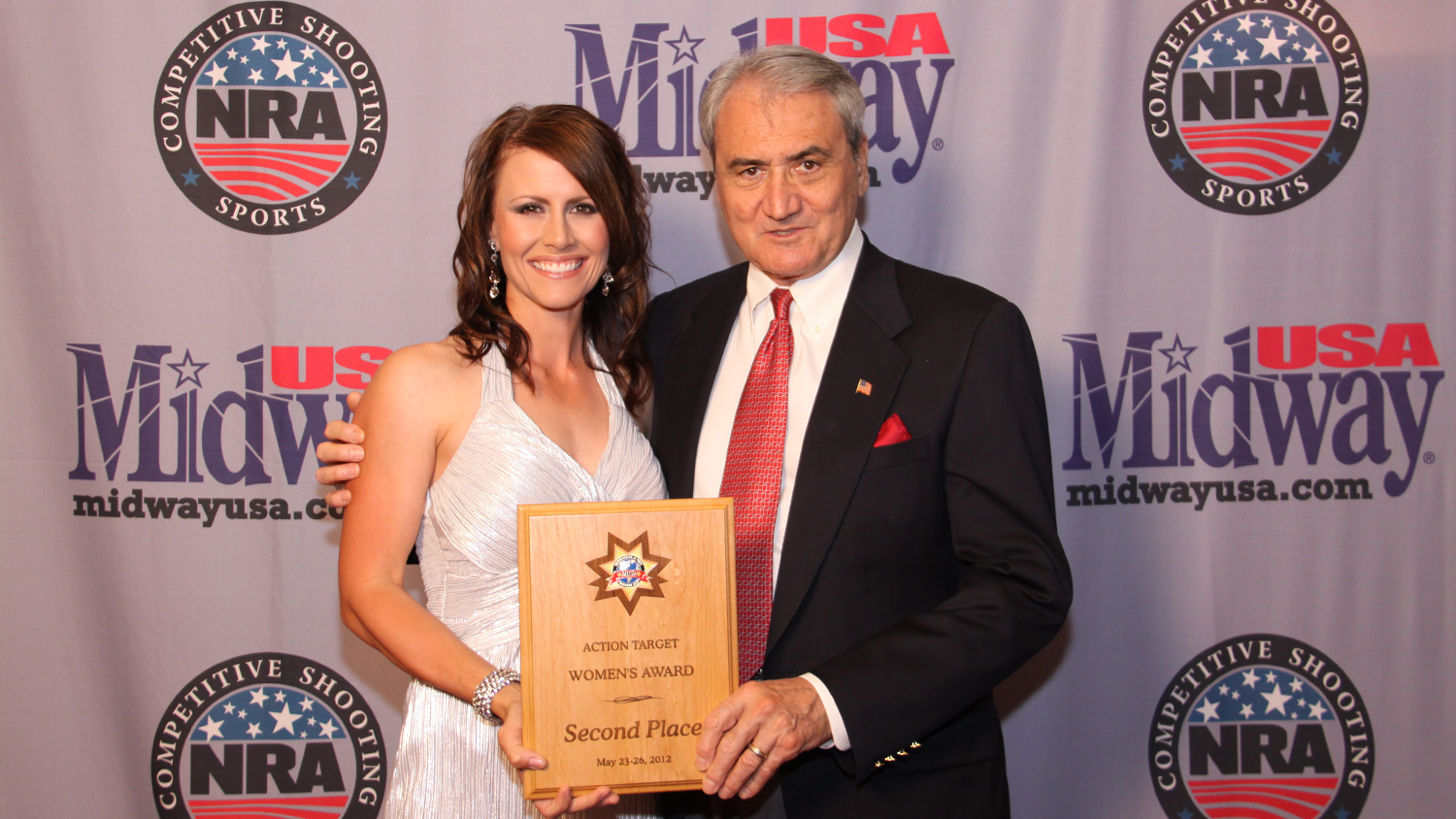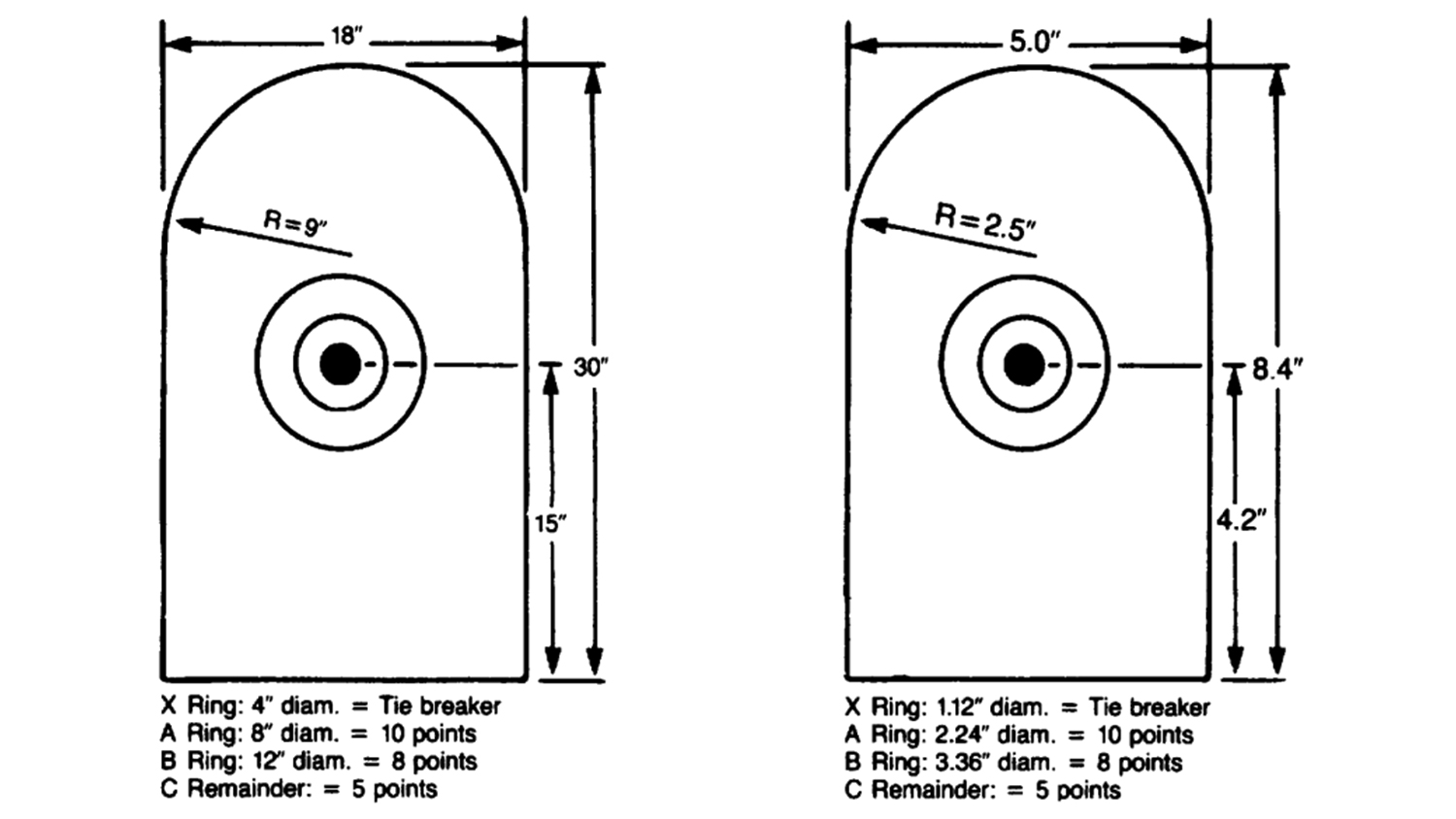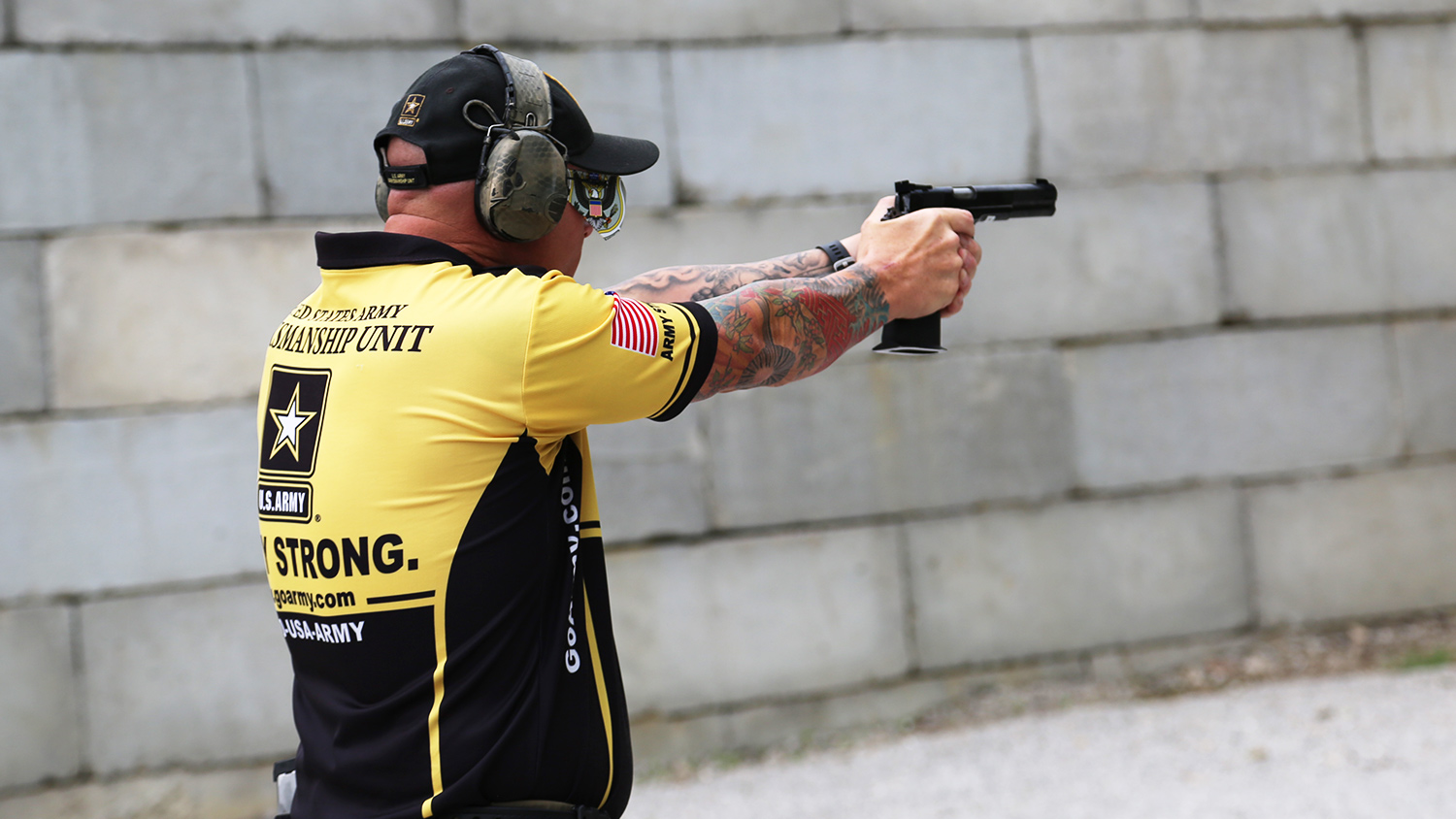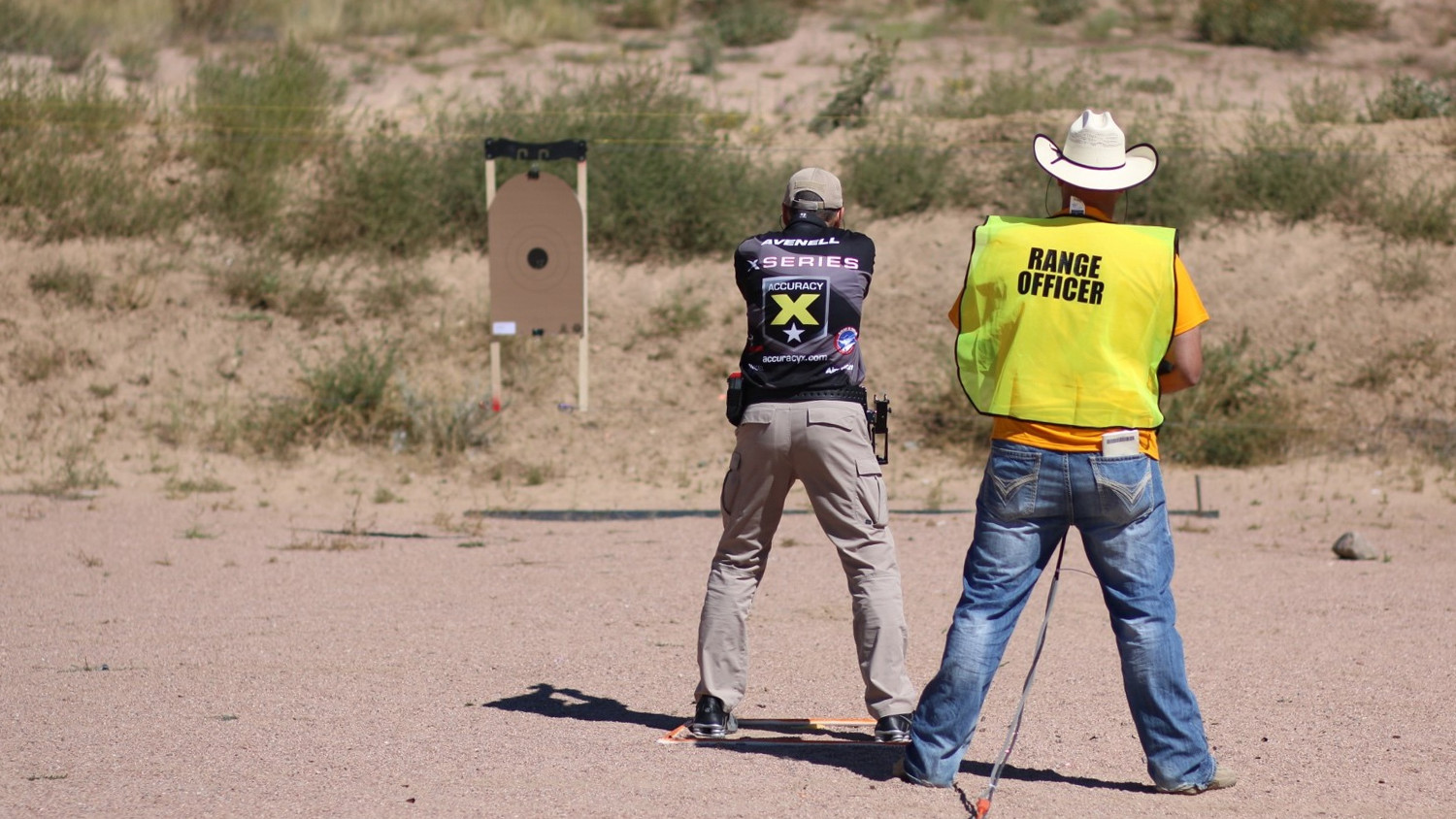Action Pistol is one of the NRA's crown jewels and is renowned as one of the world's most spectacular shooting events. Crowds gather behind the line as shooter is pitted against target in a dazzling display of speed and accuracy.
Watching today's Action Pistol stars at the Bianchi Cup can be both awe-inspiring and intimidating for someone genuinely interested in getting into the game. The top shooters are decked out in specialized rigs, with comped race guns and lead-adjustable optics designed explicitly for the Mover. The Mover alone is enough to strike fear into the most valiant of shooters.
Getting started in NRA Action Pistol, however, may be much easier than you might think.
The beginnings

John Bianchi presenting Jessie Duff with a plaque at the 2012 Bianchi Cup Awards Ceremony.
In 1979, John Bianchi, a former police officer and founder of holster giant Bianchi International,
instituted a new type of pistol match designed to test a variety of real-world handgun shooting skills. Officially named the Bianchi Cup Invitational Pistol Tournament, the match was intended to provide the nation's best handgunners with four challenging courses of fire, as well as thousands of dollars in cash and merchandise prizes, including the Bianchi Cup trophy, to the overall winner of the Tournament. Bianchi hoped that his match would present pistol shooting as a gentleman's sport having the same level of respectability and spectator interest as golf and tennis.
The Bianchi Cup Tournament was similar to the other popular "practical" shooting sports of the day
—Police Pistol Combat (PPC), and International Practical Shooting Confederation (IPSC)—in that each string, or series of shots, started with the gun in the holster, and was completed in only a few seconds. It resembled PPC in that it emphasized precision marksmanship.

The program from the very first Bianchi Cup in 1979.
In its inaugural year, the Bianchi Cup match comprised four stages, or individual courses of fire, each requiring 48 rounds. Three of these stages, the Barricade Event, the Moving Target Event (a.k.a. the Mover) and the Practical Event, employed a special tombstone-shaped target, which became known as the "Bianchi" target. Embossed cocentric rings on the target denoted the X-ring and the 10- and eight-point scoring zones. Shots hitting the target outside those rings counted five points. The total possible score for each stage was 480 points. The fourth event in the first Bianchi Cup, the Falling Plate Event, offered the shooter 48 eight-inch round steel plates arranged in banks of six at distances of 10 to 25 yards, under varying time limits. Each plate hit and knocked over scored 10 points, for a total of 480 points. Thus the total possible points for a match was 4x480, or 1920.
NRA re-designated the match as the National Action Pistol Championship in 1984 and assumed operational control of the contest in the following year. Bianchi International presented the Bianchi Cup to NRA in 1985, and since that time the trophy has been awarded annually to the National Action Pistol Champion.
Action Pistol today
NRA built on what had already been a strong foundation, increasing attendance at the annual Bianchi Cup and instituted a program of regional, state and local Action Pistol matches. Today, there are hundreds of officially sanctioned competitions held each year throughout the country, with thousands of shooters participating. Many clubs also run unsanctioned matches, as well as individual Action Pistol stages.

Julie Golob shooting the Barricade Event at the 2016 Bianchi Cup.
Since its inception, the Cup's specific stages fired and total round count have varied. At present competition for the Bianchi Cup trophy is based on the four original stages—the Barricade Event, the Moving Target Event, the Falling Plate Event (renamed the Olin "Oli" C. Barjenbruch Falling Plate Event in 2013), and the Practical Event—with a point total of 1920. Since Doug Koenig's winning 1920-157X score in 1990, a "possible" has been pretty much the requirement to be in contention. Nine other stages are also sanctioned for use in official NRA competition, providing the shooter with a broad range of challenges and some additional official targets, such as the steel speed plate. Many stages may also be fired indoors using a reduced-size paper target.

The AP-1 (left) and AP-2 targets used for Action Pistol competition.
For 2017, the standard Bianchi Cup course of fire (Match X) will be conducted over three days. The Colt Championship Final will be fired the fourth and day of the match. Match X will be used as a qualifier to the Colt Championship Final. The National Action Pistol Champion will be determined by the scores of the Colt Championship Final fired by the qualifying competitors from Match X. Meaning, the scores from the Colt Championship Final will be the sole factor in determining the winner of the NRA Bianchi Cup National Action Pistol Championship; and to reach said Finals, competitors that are in the hunt will have to make the cut during Match X.
Scores fired in NRA-sanctioned matches establish a shooter's classification as Marksman, Sharpshooter, Expert, Master or High Master. This system ensures that a shooter competes only against those of similar skill, and provides opportunities for recognition throughout a shooter's career.
The gear

A tricked-out race gun for use in Open Division, like the Taurus Jessie Duff is using here, is not necesarry to be successful in Action Pistol.
Getting started requires little more equipment than eye and ear protection, a holster allowing good retention and a safe draw, a few extra magazines or revolver speedloaders and a safe, reliable center-fire handgun of at least 9x19mm caliber. Ammunition used in official Action Pistol matches must achieve a minimum power factor of 120 (which is calculated by multiplying bullet weight in grains by velocity in feet per second (fps), and dividing by 1,000). Although most experienced competitors use handloads, the beginner would perhaps be better off to use factory fodder that is reliable and accurate in the handgun to be used.
The predominant cartridge among Action Pistol shooters is the .38 Super or it's variants. Around the country, 9x19mm, .38 Special, .40 S&W and the venerable .45 ACP are also popular. For many competitors, the more powerful revolver and autoloader cartridges are generally considered to be too punishing over the 192-round course of fire, and prevent the quick recovery needed to shoot well under time. Though most of these cartridges will easily exceed the 120 power factor in standard loadings, many .38 Special factory loads are right on the edge; check the published velocity data or, better yet, use a chronograph if one is available to you. A chronograph is an excellent auxiliary piece of gear, as it allows the experienced handloader to make ammunition just slightly above the power floor.
A timer is another useful, though not necessary, piece of equipment. An electronic timer issues a start signal (a "beep") and then times the interval between that signal and subsequent shots. A timer is useful in several ways: for assessing draw speed, for practicing shooting a string within the prescribed time limit and for simulating match conditions.

Two-time Metallic Division Champion Patrick Franks of the U.S. Army Marksmanship Unit shooting the Practical Event in 2016.
As in many other shooting disciplines, advanced shooters may opt to use highly customized, compensated, optical-sight guns that cost thousands, and draw them from specialized competition holsters. For beginners or those wishing to improve their duty- or carry-gun shooting skills through competition—or those who just want to have fun—this level of sophistication and expense isn't necessary; a stock handgun and an inexpensive kydex, nylon or leather belt holster will be just fine to get started in the Production Division. In fact, the advantage conferred by custom, high-dollar equipment is generally significant only to top-level competitors seeking to get a few more Xs. Excellent scores can be shot using what are little more than "stock" guns. Mickey Fowler used a Colt M1911 with iron sights, no compensator and a six-inch slide—essentially a stock pistol—to shoot an 1879-85X to win the Cup in 1980. In 2015, revolver shooter Anita Mackiewicz of Australia won the Bianchi Women's Championship, but missed becoming the first woman at the Cup to shoot a perfect 1920 by only four points—1916-166X.
Technique
The best way to prepare for Action Pistol competition, according to both Fowler and five-time Bianchi Cup winner Bruce Piatt, is to practice the fundamentals, especially trigger control, sight alignment and follow-through. Keep all your shots in the 10-ring at a slow-fire pace before attempting to shoot within Action Pistol time limits. Establish a cadence, especially in the Falling Plate and Moving Target events.

Seventeen-time Bianchi Cup Champion Doug Koenig (foreground) shooting the Practical Event.
Those inexperienced in drawing and firing from a holster should practice this technique carefully, with an emphasis on proper technique and safety rather than on speed. Proper technique can be learned from more experienced shooters, from books, videos and other sources online. Speed—safe speed—will not come from forcing the hand or arm to go faster, but from practice that develops smoothness and eliminates superfluous motion. Dry firing, with an empty gun in a safe direction, may be useful to develop draw coordination and "muscle memory."
Though there are variations in draw techniques and shooting stances, a universal rule is to keep your finger off the trigger until you are ready to shoot. With semi-autos having a manual safety, the safety is left on until the pistol is starting to point at the target, though the sights may not yet be completely in proper alignment. Be aware that any accidental discharge will, at the very least, usually result in an immediate match disqualification.

James Avenell competing at the 2016 Steamboat Challenge Action Pistol Regional in Cheyenne, WY.
Probably the best way to practice specific Action Pistol skills is to participate in a local match. If you are able to shoot at a range having open areas designated specifically for practical-pistol-style shooting, you may be able to simulate some of the individual events. For example, use eight-inch paper plates (or coffee filters, as former SSUSA Managing Editor Chip Lohman has in the past) to simulate the Falling Plate event, or use an old door propped up with 2x4s for the Barricade.
Success in NRA Action Pistol competition requires a combination of accuracy and speed that both the novice and the seasoned handgunner will find challenging. And while it is an excellent way to hone handgun skills, it is also a lot of fun!










































